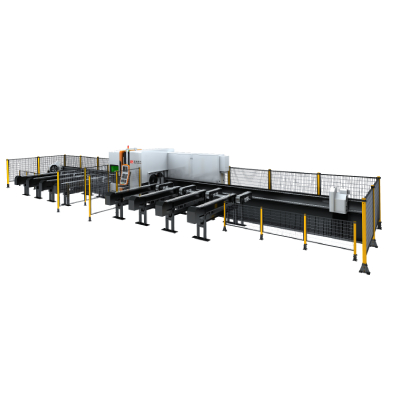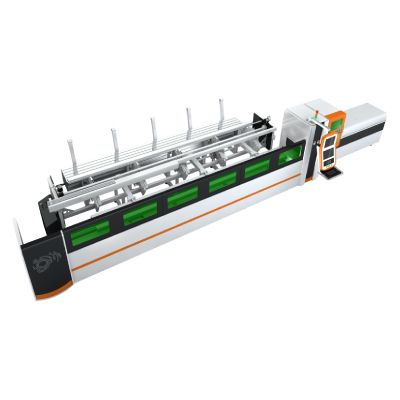In the fast-paced world of metal fabrication, efficiency and precision have become the cornerstones of successful manufacturing processes. This is where the Steel Automatic Cutting Machine comes into play, offering a transformative solution for industries requiring high-quality metal cutting. With its ability to streamline operations, reduce waste, and enhance product quality, the Steel Automatic Cutting Machine is redefining traditional methods and setting new standards in the metalworking sector.

Revolutionizing Metal Fabrication: The Advantages and Applications of the Steel Automatic Cutting Machine
The Evolution of Metal Cutting Technologies
Historically, metal cutting has relied heavily on manual processes and less efficient machinery. Workers would spend countless hours measuring, cutting, and preparing materials, often leading to inconsistencies and waste. The adoption of CNC (Computer Numerical Control) machines marked a significant turning point, enabling greater automation, precision, and repeatability in manufacturing. This technology has since evolved, leading to the development of the Steel Automatic Cutting Machine, which integrates advanced features that maximize efficiency.
Key Features of Steel Automatic Cutting Machines
1. **Precision Cutting**: One of the most significant advantages of the Steel Automatic Cutting Machine is its ability to deliver precise cuts consistently. Utilizing advanced software and cutting-edge technology, these machines can cut materials to exact specifications, minimizing the risks associated with human error.
2. **Speed and Efficiency**: The automation of the cutting process drastically reduces the time required to complete jobs. With rapid processing capabilities, these machines can perform complex cutting tasks in a fraction of the time it would take manual operators, increasing the overall throughput of manufacturing operations.
3. **Material Versatility**: Steel Automatic Cutting Machines are not limited to just one type of material. While they excel in cutting steel, many can also handle other metals and materials, including aluminum, brass, and composites. This versatility makes them an invaluable asset for various industries, from automotive to aerospace.
4. **Economic Efficiency**: By reducing material waste and optimizing cutting patterns, these machines can lead to significant cost savings. Businesses can reduce their raw material expenses while increasing output, ultimately improving profit margins.

Revolutionizing Metal Fabrication: The Advantages and Applications of the Steel Automatic Cutting Machine
5. **User-Friendly Interface**: Modern Steel Automatic Cutting Machines often come equipped with intuitive controls and user-friendly software, making them accessible to operators with varying levels of technical expertise. Training staff to operate these machines is usually less time-consuming, allowing for a quicker integration into existing workflows.
Applications in Various Industries

Revolutionizing Metal Fabrication: The Advantages and Applications of the Steel Automatic Cutting Machine
The Steel Automatic Cutting Machine is utilized across a wide range of industries, each benefiting from its unique capabilities:
– **Construction**: In the construction sector, the demand for precision-cut steel is ever-growing. Automatic cutting machines streamline the fabrication of structural steel components, ensuring quick delivery and adherence to project timelines.
– **Automotive**: The automotive industry relies heavily on metal components that require precise cutting. These machines enable manufacturers to create complex parts quickly and efficiently, contributing to the industry’s need for speed and reliability.
– **Aerospace**: Safety and precision are paramount in aerospace manufacturing. Steel Automatic Cutting Machines help produce components that meet the stringent standards of the aerospace sector, ensuring high levels of quality control.
– **Shipbuilding**: The shipbuilding industry also benefits significantly from the capabilities of automatic cutting machines. They can handle large sheets of steel, providing the accuracy needed for the intricate designs and structures involved in ship manufacturing.
Environmental Considerations
In today’s environmentally conscious world, the Steel Automatic Cutting Machine contributes to sustainability efforts in several ways. By optimizing cutting patterns and minimizing waste, these machines significantly reduce the amount of scrap generated during the manufacturing process. Additionally, the energy efficiency of modern machines helps lower carbon footprints, aligning with global efforts to combat climate change.
Conclusion
The Steel Automatic Cutting Machine represents a significant leap forward in metal fabrication technology, perfecting the delicate balance between efficiency, precision, and sustainability. As industries continue to evolve, the integration of such advanced equipment will undoubtedly remain pivotal to maintaining competitive advantages in the market. For companies looking to enhance their manufacturing capabilities, investing in a Steel Automatic Cutting Machine may prove to be one of the most beneficial decisions they can make, positioning them for success in an increasingly demanding landscape. Fiber Metal Cutting Machine
